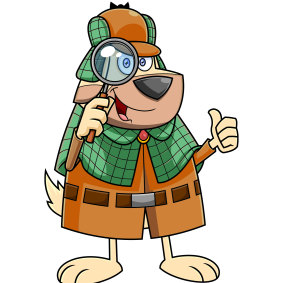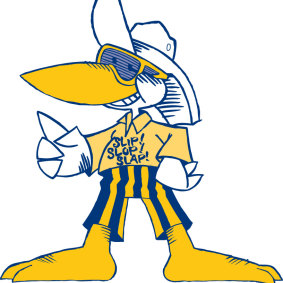Opinion
How do children tell if online news is fake? Here’s a slip, slop, slap-up idea
Bryce Corbett
Journalist, author and founder of NewshoundsWhen I was a kid, a big yellow cat with a Cheshire grin taught me how to cross the road. His name was Hector The Cat, and you couldn’t turn on the Saturday morning cartoons without bumping into him.
“Stop at the kerb, look to the right, look to the left, look to the right again,” he sang, in an advertising jingle that is still imprinted on my memory. I learned about skin cancer prevention in much the same way. A roughly hewn cartoon seagull called Sid extolled the virtues of “Slip! Slop! Slap!” in a mantra that millions of Australians still repeat to this day.
At primary school, I remember countless winter mornings heading to the council pool to hurl myself fully clothed into the deep end to retrieve a brick. Why? Because parents, teachers, and governments understood that when it came to saving the next generation from drowning, melanoma and being mowed down by traffic prevention was better than the cure.
It’s a principle that’s worth revisiting as the parliamentary inquiry into social media and Australian society unfurls in our nation’s capital. A panel of our elected representatives is trying to untangle the Gordian knot of how to minimise the impact that prolonged scrolling on Facebook, TikTok and Instagram is having on us. And at its heart are concerns about the mis- and disinformation we’re increasingly exposed to. Fake news that can mislead entire swathes of the population, sway elections and undermine democratic processes.
With Meta deciding to pull out of the News Media Bargaining Code – cutting millions from the bottom line of media companies all over the country and removing credible news from Facebook and Insta feeds – there will definitely be a corresponding uptick in the amount of fake news to which Aussies are exposed. Such has been the experience in Canada. And so the question is: how to combat it?
Age verification on social media sites has been proposed to mitigate the problem, as there are bans for people under 16. And, certainly, regulation must be a part of the solution. But if we’ve learnt anything from Sid and Hector, surely it’s that education has to underpin it all. And very specifically, in this case, media literacy education delivered in a co-ordinated national effort and, crucially, at a young age – before our kids disappear into the social media vortex.
Media literacy means teaching kids to be critical consumers of information. It means teaching them to recognise misinformation when they come across it online. Lessons which common sense dictates should be taught before they have a smartphone in their hands.
As Australia’s eSafety Commissioner Julie Inman Grant told the parliamentary inquiry on June 28, we don’t send our kids to the beach without teaching them how to swim, so why are we blithely letting them loose in the wild west of the internet without teaching them to think critically about the flood of information they will encounter there?
Or, to use another analogy, if we as a society are vigilant about immunising our kids against diseases that could warp their adult lives, why are we not inoculating them against misinformation with the same urgency?

Meet Squiz-E the Newshound.
Make no mistake, Australian parents consider this to be nothing less than a national emergency. In a recent survey of its combined audiences, the Squiz Today and Squiz Kids podcasts polled more than 1000 Australian parents and teachers.
When asked to identify their number one concern for kids online, 82 per cent of respondents nominated exposure to disinformation – ranking it significantly higher than exposure to pornography (76 per cent) and meeting strangers online (56 per cent). Interestingly, while 95 per cent agreed age verification for social media sites was an important measure, 93 per cent said their kids would find a way around it.
It’s why, with seed funding from the Google News Initiative, Squiz Kids created Newshounds, a media literacy resource for primary school classrooms. Taking his lead from Sid and Hector, a cartoon detective dog called Squiz-E the Newshound teaches kids to “Stop, Think & Check” before believing everything they see, read or hear online.
It also goes a long way to explaining why no fewer than 2600 teachers from around the country have signed up to do Newshounds since its launch 18 months ago.

Sid Seagull: So effective you probably still remember his sun safety message.
With this parliamentary inquiry, our leaders now have an opportunity to bring Australia up to speed with countries like Finland and Estonia, where proximity to Russia and its famed disinformation farms has made media literacy education part of the primary school curriculum for almost 20 years. It’s a chance for us to follow the lead of California – which just last year instituted mandatory media literacy lessons for all K-12 students in all public schools. Similar initiatives have been undertaken in the US states of Delaware, New Jersey and Texas.
If I’ve learnt anything as a children’s podcaster and dad of two, it’s that kids are smart. And importantly, when they’re at primary school, they’re still impressionable. Let’s channel Hector and Sid, harness those smarts and instil in the next generation the vital skill of how to discern online fact from fiction.
There’s nothing less important than the future of our democracy at stake.
Bryce Corbett is a journalist, four-time published author and the creator of Newshounds, a media literacy program for primary school kids.
The Opinion newsletter is a weekly wrap of views that will challenge, champion and inform your own. Sign up here.